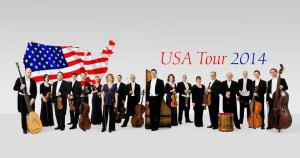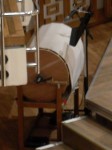 The English Concert played to a packed house at Spaulding on Friday night. There was a correction to the program in that the first piece was titled Suite for 2 Horns, 2 Oboes and Strings in F Major by Telemann (and not the Suite in D Major as listed). I particularly enjoyed watching the double bassist, who looked like he was really having fun, especially with the last Fanfare movement.
The English Concert played to a packed house at Spaulding on Friday night. There was a correction to the program in that the first piece was titled Suite for 2 Horns, 2 Oboes and Strings in F Major by Telemann (and not the Suite in D Major as listed). I particularly enjoyed watching the double bassist, who looked like he was really having fun, especially with the last Fanfare movement.
The Bach Orchestral Suite was a surprise in that it was a small chamber group: 2 violins, viola, cello, harpsichord and transverse flute (flute traversière). My recording must have been with larger chamber groups, but it still worked well. The flautist was amazing, especially the last movement.
For the Trumpet Concerto, the soloist played a natural trumpet. In the Q&A, he demonstrated how he played a scale by shaping his lips, and not using valves. There is one hole that is used to adjust some notes that are slightly out of tune. In the baroque trumpet, they changed sections to adjust the length (to change key from D to F, for example), while the new ones use valves. During the piece, the horn players did in fact do this, as they had 2 different sized loops hanging from the their music stands. They also were removing the mouthpiece and shaking the loops to drain condensation.
![]() The Oboe Concerto was played with an “oboe d’amore”, a baroque oboe with a large bottom bulb and an unusual deep round sound.
The Oboe Concerto was played with an “oboe d’amore”, a baroque oboe with a large bottom bulb and an unusual deep round sound.
 For the last piece, a “windmaker” was used for the “Suite des vents”. This was a box about the size of a small organ with a hand crank on the side. The operator turned the crank which rotated a spindle against a green sheet making “windy” sounds.
For the last piece, a “windmaker” was used for the “Suite des vents”. This was a box about the size of a small organ with a hand crank on the side. The operator turned the crank which rotated a spindle against a green sheet making “windy” sounds.
After the show, there was a Q&A section with the conductor and 5 performers. They all play on baroque instruments. For the strings, the bow is different, as it bends out (like a bow and arrow) and not in like a modern bow. Modern bows give a more even sound, but the older bows allow them to “shape” the notes, with a different down on up and down bow. The ribbon is much thinner too. When playing they do not use very much vibrato, which makes tuning very important, and they did spend a lot of time on tuning between pieces. Another interesting instrument was the heorbo, like a giant guitar or lute with 17 strings. The long strings are bass strings that provide a continuo through resonation.
The performers had all started on modern instruments and then transitioned to baroque. The oboist was the exception. When she started, she had a lot of trouble playing, so her teacher had her use the oboe d’amore, which is easier to make a note on.
And as I left, I saw the charter bus outside with the group getting on, setting off at 10:30 pm for their next venue.
